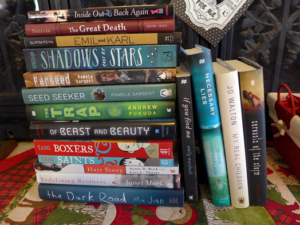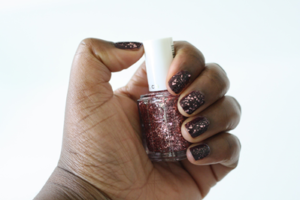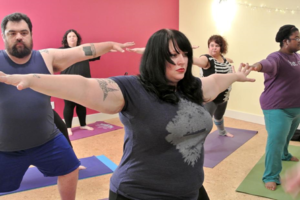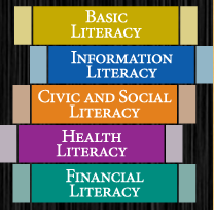You’ve surely seen or heard the phrase “New Year, New You” before- whether on a magazine cover, a television show, or even a library display (like one I created last January!) While it’s often the New Year when many make resolutions to break a bad habit, improve their health through diet and/or exercise, or generally resolve to alter their lives in some manner- we receive messages year round from various sources implying that we should all consider changing ourselves in some way. While such news stories, magazine articles, and information online can be powerful kickstarts to help people enact desired changes, I want to call attention to the push towards greater acceptance of ourselves, and the focus on self-care activities that improve mental and physical well-being.
Most people experience stress- whether it originates from their work, families, friends, or the world at large. Acute stress can negatively affect every major system in our bodies. In particular, those who work with the public, like many library staff, know all too well the challenges that can accompany such positions. Finding ways to manage stress, decompress, and engage in self-care activities helps our public and our fellow library workers avoid burn-out and maintain satisfaction in their careers and lives. Awareness of these pertinent resources and techniques helps library staff better introduce their customers to these tools.
Many libraries and other organizations have created pathfinders and resource lists for all ages that promote self-acceptance (whether it’s one’s body, sexuality, race, gender, and more), or ways to manage stress. The Montana State University Library compiled a great collection of resources to help their students decrease stress levels. The 1000 Black Girl Books Resource Guide, created from the #1000blackgirlbooks campaign led by 12 year old Marley Dias is a continually growing database of books featuring female African-American characters. Dias herself explains: “I think it is important that if we want the world to be a better place where everyone feels welcomed and understood then we must sure that children have books about black girls, and all kinds of people, not just white boys and dogs.”
This young visionary from Philadelphia points to the importance of the public library supporting diversity of all forms in our collections. Jamie Campbell Naidoo (2014) explained how diverse books can positively impact the reader’s self-image: “Children’s materials that accurately portray diversity in multiple languages and cultures can have a positive influence on a child’s self-image and help him or her build bridges of cultural understanding.” (“The Importance of Diversity in Library Programs and Material Collections for Children,” Association for Library Service to Children, p. 3) Indeed, fewer than 10 percent of children’s books released in 2016 had a black person as the main character, according to the yearly report presented by the Cooperative Children’s Book Center at the University of Wisconsin, Madison.
 Diversity in representation is a topic that affects readers of all ages. In 2015, four bloggers (including a few librarians) created the “Size Acceptance in YA” Tumblr, examining “fatness, fatphobia, body shaming, body policing, body objectification, and all other things relating to size and body acceptance in YA literature.” Their attention to titles both successful and problematic in how they address body issues helps librarians, educators, and readers consider this topic that is often glossed over. Kelly Jensen, one of the creators of the Tumblr, demonstrates the need for this attention, as she explained in a Book Riot article “Combating Fat Phobia in YA Lit” that “I can count on a single hand the books that depict a fat character as a whole, worthy being who can do what s/he wants to without being “held back” by their body.”
Diversity in representation is a topic that affects readers of all ages. In 2015, four bloggers (including a few librarians) created the “Size Acceptance in YA” Tumblr, examining “fatness, fatphobia, body shaming, body policing, body objectification, and all other things relating to size and body acceptance in YA literature.” Their attention to titles both successful and problematic in how they address body issues helps librarians, educators, and readers consider this topic that is often glossed over. Kelly Jensen, one of the creators of the Tumblr, demonstrates the need for this attention, as she explained in a Book Riot article “Combating Fat Phobia in YA Lit” that “I can count on a single hand the books that depict a fat character as a whole, worthy being who can do what s/he wants to without being “held back” by their body.”
Several libraries also offer programs and workshops that promote self-care and acceptance, to help improve the overall well-being of their patrons. In the same vein, several libraries offer collections of resources that promote mindfulness, stress-reduction, and mental and physical wellness to help their patrons learn to better care for themselves. The Cumberland Public Library in Rhode Island recently offered a program, “Self Care for the Entire Year” perhaps in response to the common New Year’s resolutions of changing something about yourself, to instead focus on helping people to engage in self-care, self-acceptance, and generally feeling good about who they are year-round.
The Lawrence Public Library in Kansas created an inventive program “‘Light’ Reading at Your Library”, which offered lights that help combat Seasonal Affective Disorder in their auditorium, creating comfortable seating areas, stocked with enjoyable reading materials and information about preventing and treating seasonal depression. The Skokie Public Library in Illinois recently offered “Self-Care 101: Mapping the Body”. In New Jersey, the Piscataway Public Library brought in a social worker to help their patrons learn “Self-Care to Avoid Burnout”. In Ohio, the Springboro Public Library even offered a program to teach attendees about “Self Care Massage”. Closer to home, the Mt. Lebanon Public Library in Pennsylvania recently offered the program “Chasing the Winter Blues Away” to teens and adults, led by a counselor who discussed Basic Mindful Cognitive Behavior Therapy (MCBT), positive psychology, movement, and self care techniques.
The Carnegie Library of Pittsburgh- Knoxville hosted a series of weekly programs for teens throughout February called “Love Yourself”, providing a space for teens to chat and learn about what it means to respect themselves and their bodies- through programs focused on nutrition, beauty, and hygiene, with an eye toward how these topics can influence relationships. Teen Specialist Nicole Lowry explained that the response of the teens has been so enthusiastic that she plans to continue the series beyond February. She originally thought of the program idea as a tie-in with Valentine’s Day, but with a focus on loving yourself rather than just talking about romantic relationships. She wanted to highlight the importance of taking care of yourself for you rather than because of peer pressure, or to please others.
Lowry came up with the idea for the program series in response to the topics she heard her teens talking about- by paying attention to her patrons, she noticed their interest in relationships and dating. She noted, “I didn’t have anyone when I was that age talking to me about how healthy relationships should be. I wish I had someone to tell me- you should do things for yourself, not for another person, not because you want to impress another person, or because your boyfriend or girlfriend says that you should change.”
 For the first week’s program, she offered a manicure tutorial to try to catch their interest right away. She used instructional Youtube videos to teach 3 boys and 6 girls how to care for their nails. Lowry explained that she’s a “Youtuber” herself, and uses the video sharing website frequently herself to learn about new ideas and techniques. The program was a success from the start, with Lowry saying that “They loved it! I definitely emphasized the ‘man’ in ‘manicure’ so the boys knew it was for them, too. It even lasted longer than the hour it was intended for.” Skin was the topic for the second week, where the teens learned about makeup, age-appropriate tips, and how to care for your skin on a budget. Lowry said that she always makes sure to incorporate parts of her life, as the teens “appreciate it a lot. . . it took me awhile to figure out if I share parts of my life that I’m comfortable with, with them, they react more positively to me.” One way she connected personally was by talking about acne and home treatments she’s tried. Instead of just showing them a how-to Youtube video about making homemade oatmeal masks, she gave them the opportunity to make masks themselves. She noted that some of her teens lack home internet access, so they couldn’t watch such videos without the library.
For the first week’s program, she offered a manicure tutorial to try to catch their interest right away. She used instructional Youtube videos to teach 3 boys and 6 girls how to care for their nails. Lowry explained that she’s a “Youtuber” herself, and uses the video sharing website frequently herself to learn about new ideas and techniques. The program was a success from the start, with Lowry saying that “They loved it! I definitely emphasized the ‘man’ in ‘manicure’ so the boys knew it was for them, too. It even lasted longer than the hour it was intended for.” Skin was the topic for the second week, where the teens learned about makeup, age-appropriate tips, and how to care for your skin on a budget. Lowry said that she always makes sure to incorporate parts of her life, as the teens “appreciate it a lot. . . it took me awhile to figure out if I share parts of my life that I’m comfortable with, with them, they react more positively to me.” One way she connected personally was by talking about acne and home treatments she’s tried. Instead of just showing them a how-to Youtube video about making homemade oatmeal masks, she gave them the opportunity to make masks themselves. She noted that some of her teens lack home internet access, so they couldn’t watch such videos without the library.
For the third week, Lowry invited one of the teen’s moms to teach them how to do head-wraps, as a tie-in with Black History Month. Several of her teens already like wearing scarves, so this parent showed them new ways to wear head-wraps, and incorporated lessons about hair care. Lowry shared tips that work for her own hair and explained to the teens that she learned how to care for her hair on her own to maintain her natural hairstyle. For the fourth week, Lowry will be partnering with a nutritionist from the Allegheny Health Department to talk about how eating choices and exercising can help you stay in a healthy weight range. She explained: “I don’t want anyone to feel pressure from a significant other because of weight, or pressure from a partner to lose weight. I talked to them about my own weight-loss journey, because it came from me. Family members told me to lose weight, but it was my decision.”
Several other public libraries in Pennsylvania have also offered programs for all ages focusing on improving well-being. Abington Township Public Library is celebrating May being National Meditation Month by offering “Meditation for Healthy Living”. Smithfields Branch Library in East Stroudsburg will involve the whole family, by partnering with the PA Department of Health to offer “Healthy Eating Tips for Children”. The Crafton Public Library offers a twice-monthly group, “Healthy Pathways”, with the goal of focusing on self-love and body acceptance.
In my library system (Chester County Library System), several libraries offer programs focused on similar topics. The Oxford Library offers a monthly club, “4-H Food, Fun and Fitness”, which combines fun exercise with cooking activities. The Chester County Library recently hosted a personal trainer, who presented the program “Sitting is the New Smoking”, to educate patrons about the ills of inactivity. The Coatesville Public Library will be partnering with several community organizations (Chester County Department of Mental Health, Coatesville Area School District, and the Brandywine Health Foundation) to present “Community Conversations: Mental Health”. Libraries can even offer exercise programs to help their public discover fitness activities they enjoy. At my library, the Henrietta Hankin Branch Library, we’ve hosted a series of Pilates and Yoga programs using local instructors, and have planned a upcoming series of Tai Chi Qigong classes to introduce our patrons to this “moving meditation” that has been shown to improve physical and mental health.
Public libraries can also work to improve the well-being of their staff members by offering professional  development focused on self-care activities, highlighting helpful resources for library professionals, and simply communicating with staff regularly about the importance of taking steps to avoid burnout.
development focused on self-care activities, highlighting helpful resources for library professionals, and simply communicating with staff regularly about the importance of taking steps to avoid burnout.
We all know how hard it can be to be a human. By offering ways to increase self-acceptance, improve health, and avoid burnout through programs and collections, libraries communicate to their patrons and staff that they value their communities, and want to support and improve the complete health of its members.
Job Stress and the Librarian: Coping Strategies from the Professionals by Carol Smallwood (Author, Editor), Linda Burkey Wade (Author, Editor)
The Self-Acceptance Project: How to Be Kind and Compassionate Toward Yourself in Any Situation by Various Authors, Tami Simon, (Editor)
Undoing Perpetual Stress: The Missing Connection between Depression, Anxiety and 21st Century Illness by Richard O’Connor, Ph.D
The Power of No: Because One Little Word Can Bring Health, Abundance, and Happiness by James and Claudia Altucher
Stress Management for Dummies by Alan Elkin Ph.D
Self-Compassion: The Proven Power of Being Kind to Yourself by Kristin Neff
Every Body Yoga: Let Go of Fear. Get On the Mat. Love Your Body by Jessamyn Stanley (coming April 2017)
Things No One Will Tell Fat Girls: A Handbook for Unapologetic Living by Jes Baker
A Mindfulness-Based Stress Reduction Workbook by Bob Stahl Ph.D
Intuitive Eating by Evelyn Tribole M.S. R.D., Elyse Resch M.S. R.D. F.A.D.A.
From Coping to Thriving: How to Turn Self-Care Into a Way of Life by Hannah Braime
The A-to-Z Self-Care Handbook for Social Workers and Other Helping Professionals by Erlene Grise-Owens, Justin “Jay” Miller, Mindy Eaves
Manage Your Time to Reduce Your Stress: A Handbook for the Overworked, Overscheduled, and Overwhelmed by Rita Emmett
From Stress to Stillness: Tools for Inner Peace by Gina Lake
Real World Mindfulness for Beginners: Navigate Daily Life One Practice at a Time by Brenda Salgado
Why Zebras Don’t Get Ulcers: The Acclaimed Guide to Stress, Stress-Related Diseases, and Coping by Robert Sapolsky, Ph.D
Full Catastrophe Living (Revised and Updated 2013): Using the Wisdom of Your Body and Mind to Face Stress, Pain, and Illness by Jon Kabat-Zinn
Resources for library staff:
5min Librarian: “What You Can Do to Combat Librarian Burnout”
DBSA Wellness Tracker: an online tool to help track potential health problems and mood fluctuations in daily life.
Employee Assistance Program (EAP): your employer may offer this kind of program where you can find free and confidential assessments, short-term counseling, referrals, and follow-up services to help employees work on personal and/or work-related problems.
Free Guided Meditations from UCLA Mindful Awareness Research Center
Librarian Burnout: Maria Accardi’s blog that solicits stories of burnout from librarians, to help others feel less alone in their own stressful situations, and evaluate trends in the profession that may contribute to librarian burnout, and consider ways to lessen burnout in librarianship.
Letters to a Young Librarian: Jessica Olin explained that she started this blog because she found through interaction with new librarians that there “. . . seems that there is a gap between what library programs are teaching and what new professionals will need to know in order to be successful.” (from http://letterstoayounglibrarian.blogspot.com/2011/06/why-i-decided-to-start-blog.html)
Self-Care Starter Kit: resources from University at Buffalo School of Social Work, targeted for Social Workers, but highly applicable for library staff.



